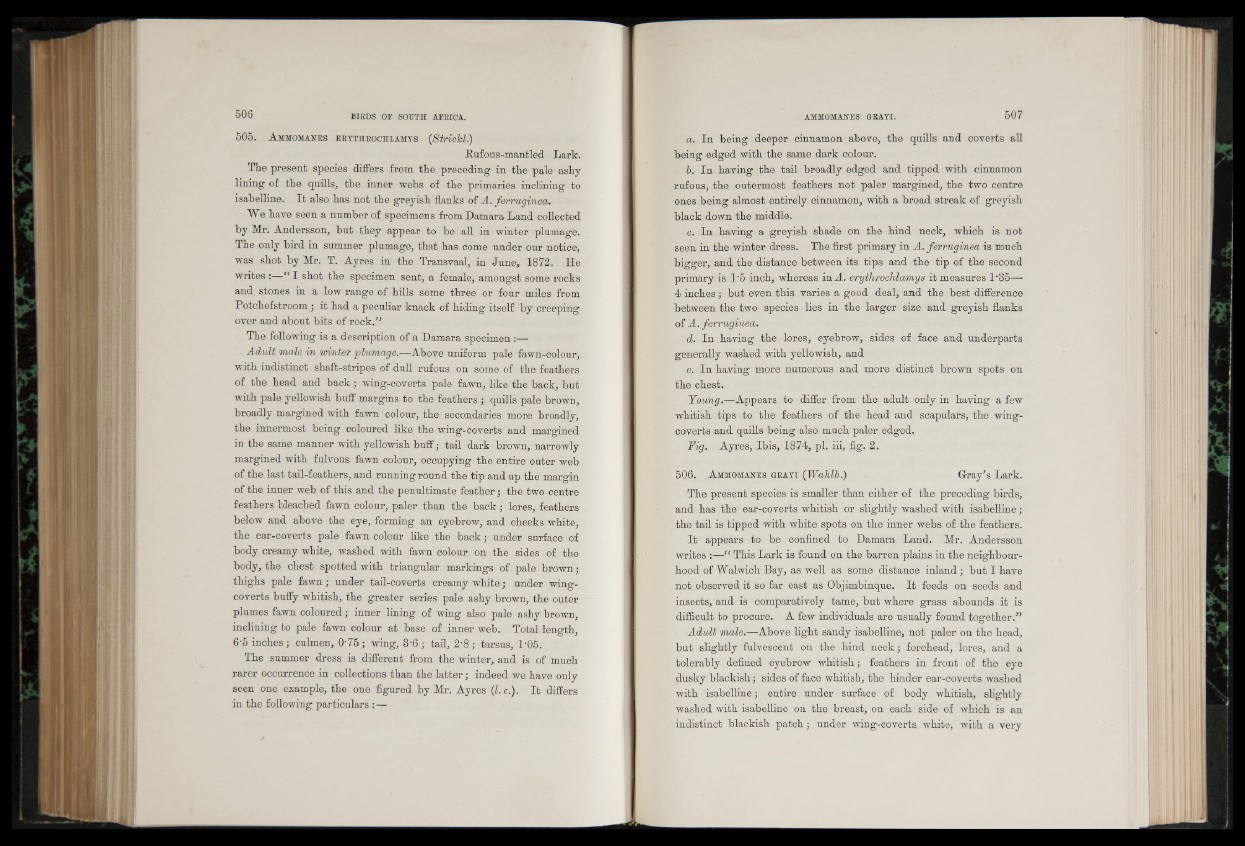
5 0 5 . A mmomanes erythrochlamys (Strichl.)
Kufous-mantled Lark.
The present species differs from the preceding in the pale ashy
lining of the quills, the inner webs of the primaries inclining to
isabelline. It also has not the greyish flanks of A. ferruginea.
We have seen a number of specimens from Damara Land collected
by Mr. Andersson, but they appear to be all in winter plumage.
The only bird in summer plumage, that has come under our notice,
was shot by Mr. T. Ayres in the Transvaal, in June, 1872. He
writes :—“ I shot the specimen sent, a female, amongst some rocks
and stones in a low range of hills some three or four miles from
Potchefstroom ; it had a peculiar knack of hiding itself by creeping
over and about bits of rock.”
The following is a description of a Damara specimen :—
Adult male in winter plumage.—Above uniform pale fawn-colour,
with indistinct shaft-stripes of dull rufous on some of the feathers
of the head and back; wing-coverts pale fawn, like the back, but
with pale yellowish buff margins to the feathers ; quills pale brown,
broadly margined with fawn colour, the secondaries more broadly,
the innermost being coloured like the wing-coverts and margined
in the same manner with yellowish buff; tail dark brown, narrowly
margined with fulvous fawn colour, occupying the entire outer web
of the last tail-feathers, and running round the tip and up the margin
of the inner web of this and the penultimate feather; the two centre
feathers bleached fawn colour, paler than the back ; lores, feathers
below and above the eye, forming an eyebrow, and cheeks white,
the ear-coverts pale fawn colour like the back; under surface of
body creamy white, washed with fawn colour on the sides of the
body, the chest spotted with triangular markings of pale brown;
thighs pale fawn; under tail-coverts creamy white; under wing-
coverts buffy whitish, the greater series pale ashy brown, the outer
plumes fawn coloured ; inner lining of wing also pale ashy brown,
inclining to pale fawn colour at base of inner web. Total length,
6-5 inches; culmen, O'75; wing, 8-6; tail, 2'8 ; tarsus, P05.
The summer dress is different from the winter, and is of much
rarer occurrence in collections than the latter; indeed we have only
seen one example, the one figured by Mr. Ayres (I.e.). It differs
in the following particulars : —
а. In being deeper cinnamon above, the quills and coverts all
being edged with the same dark colour.
б. In having the tail broadly edged and tipped with cinnamon
rufous, the outermost feathers not paler margined, the two centre
ones being almost entirely cinnamon, with a broad streak of greyish
black down the middle.
c. In having a greyish shade on the hind neck, which is not
seen in the winter dress. The first primary in A. ferruginea is much
bigger, and the distance between its tips and the tip of the second
primary is 1‘5 inch, whereas in A. erythrochlamys it measures 1‘35—
4 inches; but even this varies a good deal, and the best difference
between the two species lies in the larger size and greyish flanks
of A. ferruginea.
d. In having the lores, eyebrow, sides of face and underparts
generally washed with yellowish, and
e. In having more numerous and more distinct brown spots on
the chest.
Young.—Appears to differ from tho adult only in having a few
whitish tips to the feathers of the head and scapulars, the wing-
coverts and quills being also much paler edged.
Fig. Ayres, Ibis, 1874, pi. iii, fig. 2.
506. A mmomanes g r a y i (Wahlb.) Gray’s Lark.
The present species is smaller than either of the preceding birds,
and has the ear-coverts whitish or slightly washed with isabelline;
the tail is tipped with white spots on the inner webs of the feathers.
It appears to be confined to Damara Land. Mr. Andersson
writes :—“ This Lark is found on the barren plains in the neighbourhood
of Walwich Bay, as well as some distance inland; but I have
not observed it so far east as Objimbinque. It feeds on seeds and
insects, and is comparatively tame, but where grass abounds it is
difficult to procure. A few individuals are usually found together.”
Adult male.—Above light sandy isabelline, not paler on the head,
but slightly fulvescent on the hind neck; forehead, lores, and a
tolerably defined eyebrow whitish; feathers in front of the eye
dusky blackish; sides of face whitish, the hinder ear-coverts washed
with isabelline; entire under surface of body whitish, slightly
washed with isabelline on the breast, on each side of which is an
indistinct blackish patch; under wing-coverts. white, with a very